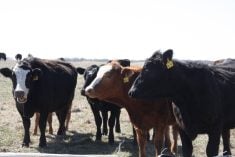Fed prices climb
In what has become unusual, four major Canadian and American packers bought western Canadian cattle last week.
Fed steers averaged $197.37 per hundredweight, up 59 cents, and heifers were $196.48, up $2.47.
Dressed sales rallied $7-$10 at mostly $329-$332 delivered.
Alberta packers had to increase bids to procure cattle and compete with the American buyers.
Sales to the United States were US$267 dressed.
The cash-to-futures basis weakened to -$5.07 but remained strong for this time of year.
In the U.S., light live trade developed late in the week at prices $2 higher in the south at US$165 live.
Read Also

Volatile temperatures expected for this winter
DTN is forecasting a lot of temperature variability in the Canadian Prairies this winter. Precipitation should be close to average.
A few dressed sales were reported in the north at $263 delivered, up $3-$4 from the previous week.
Weekly western Canadian fed slaughter to March 21 rose 12 percent to 33,485 head. For the year, slaughter is down two percent at 330,189 head.
Weekly exports to March 14 rose 16 percent to 7,412 head, which is the most this year.
Exports for the year are down 44 percent at 46,546 head. Marketings in April are expected to moderate. Market ready calves are not expected to hit the show list until early May.
Packer-owned inventories have tightened.
The strong competition and prices should continue this week.
Cow prices still strong
Non-fed supplies are anticipated to remain tight near term, and it could be another month before volumes of calving culls increase.
D1, D2 cows ranged C$136-$152 to average $144.75, down 58 cents from the previous week.
D3 cows ranged $120-$138 to average $128.80.
Rail grade cows were $277-$282.
Slaughter bulls were $155.64, down $1.59
Feeders strong
The number of heifers going to auction has risen as producers cull herds and finalize their breeding intentions.
The market will look for confirmation in the March Canfax cattle-on-feed report.
Heifer placements into feedlots over the past two months have been historically low.
Feeder prices can sometimes weaken in April and match the seasonal lows set in January, but that is unlikely this year.
October live cattle futures have strengthened seven percent from their February lows.
As well, feeder cattle for April delivery are seeing prices comparable with current cash prices.
Alberta auction volumes fell to 29,000 from 40,000 the previous week.
Weekly feeder export to the U.S. topped 16,000 head for the first time this year.
Grass buyers have been more aggressive recently on 700-750 pound steers and heifers, and prices strengthened $11-$12 over two weeks.
Demand for seed stock heifers is good, adding a premium to their prices.
Feeder and calf prices will likely level off at the start of April.
Bred cows were $2,100-$3,400 per head, and bred heifers were $2,500-$3,900.
U.S. beef climbs
U.S. boxed beef prices rose with Choice up US$4.06 at $250.67 and Select up $2.17 at $246.96, supported by reduced slaughter last week and demand for the coming grilling season.
The U.S. cold storage report was bearish for the market with beef inventories up 20 percent at the end of February from last year.
Canadian cutouts for the week ending March 21 are unavailable.
In contrast to the U.S., grading performance in Canada fell below year-ago levels since mid-March with the percentage of Prime and AAA grades at 64-67 percent compared to 68 percent last year.
This cattle market information is selected from the weekly report from Canfax, a division of the Canadian Cattlemen’s Association. More market information, analysis and statistics are available by becoming a Canfax subscriber by calling 403-275-5110 or at www.canfax.ca.














